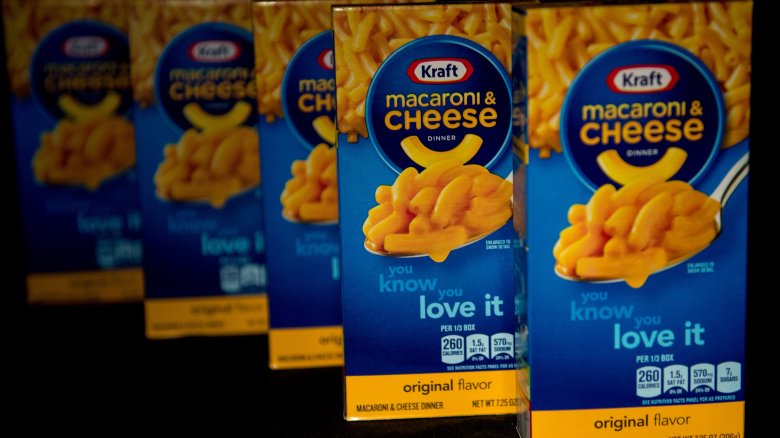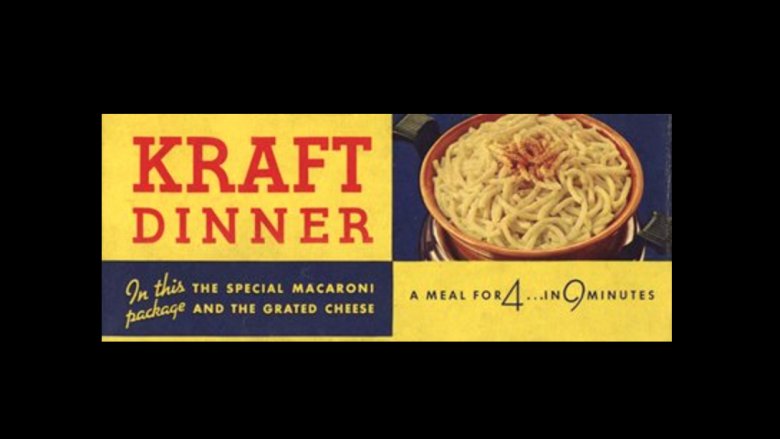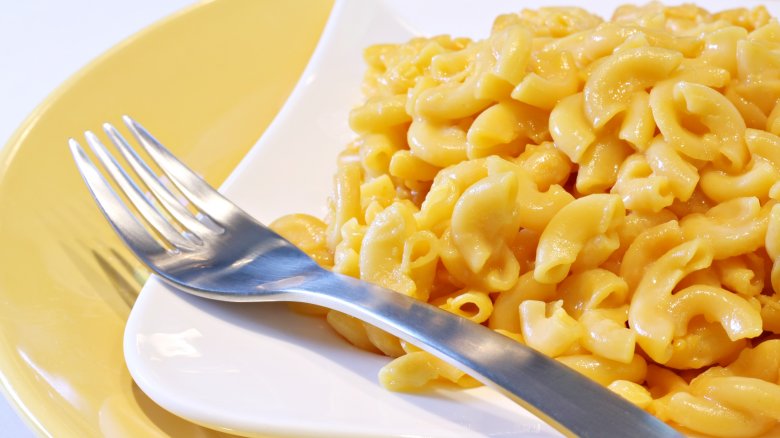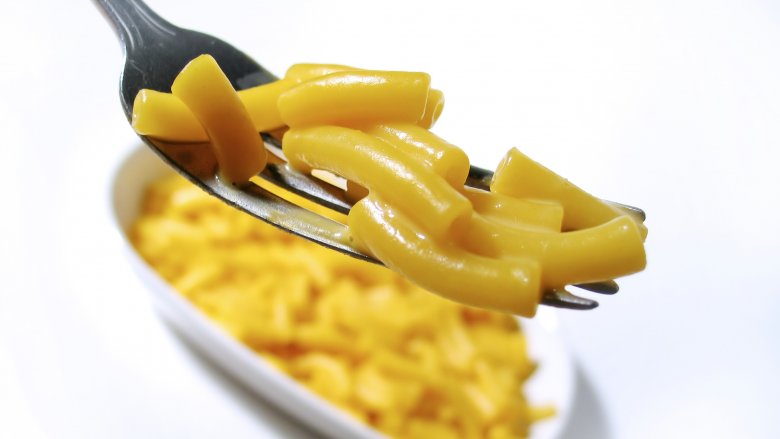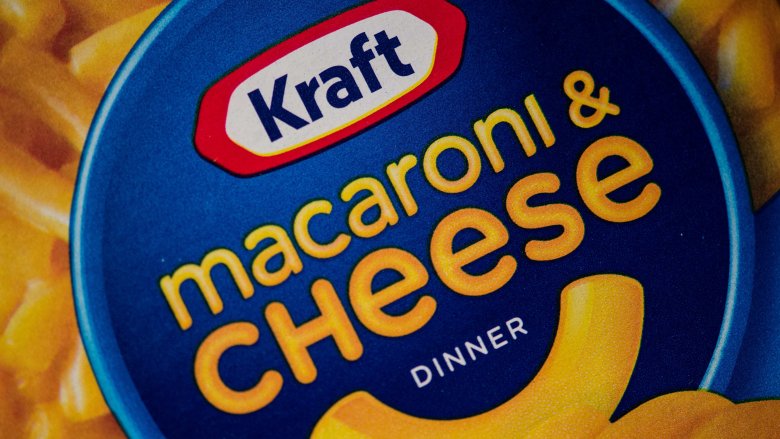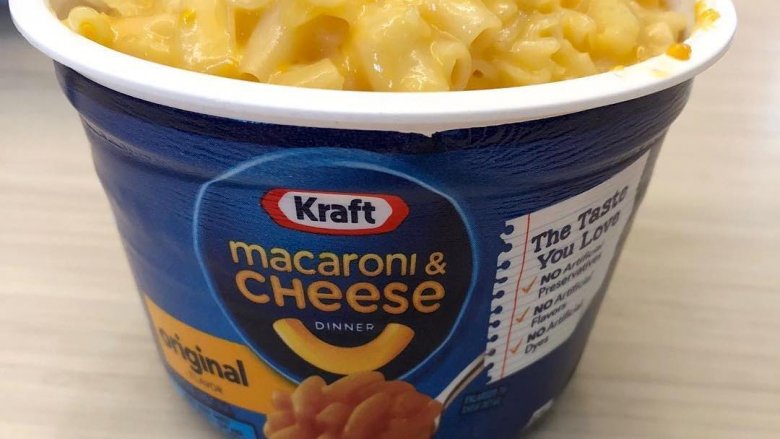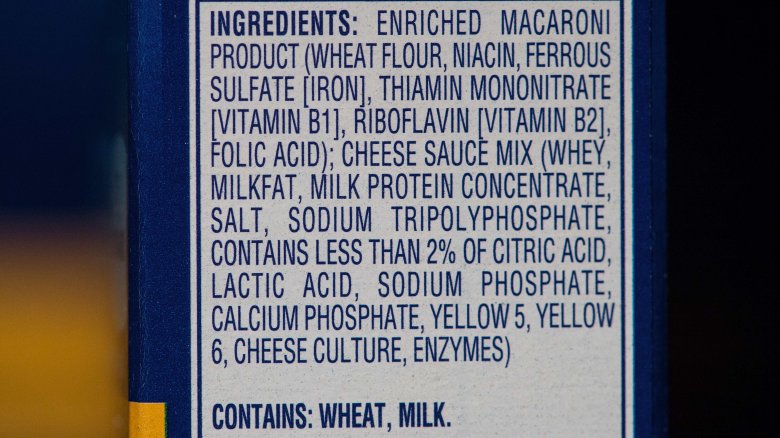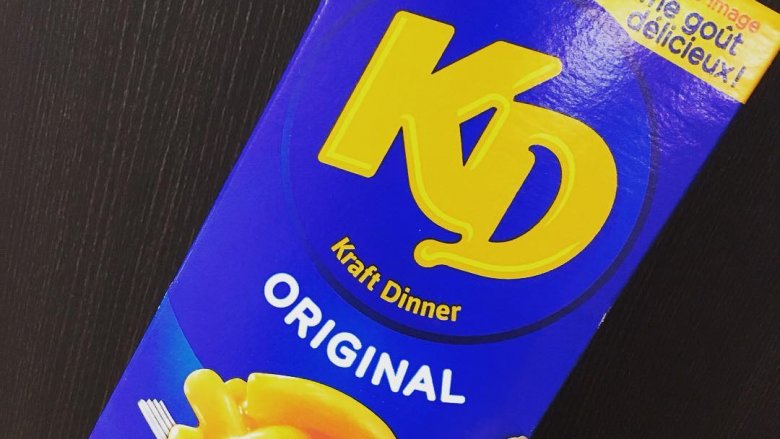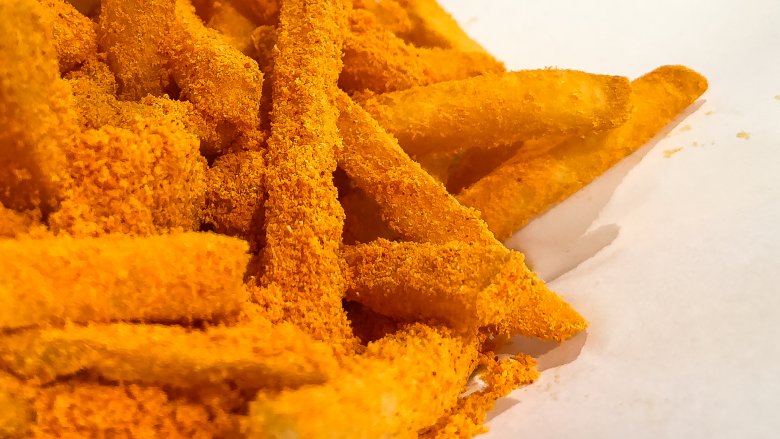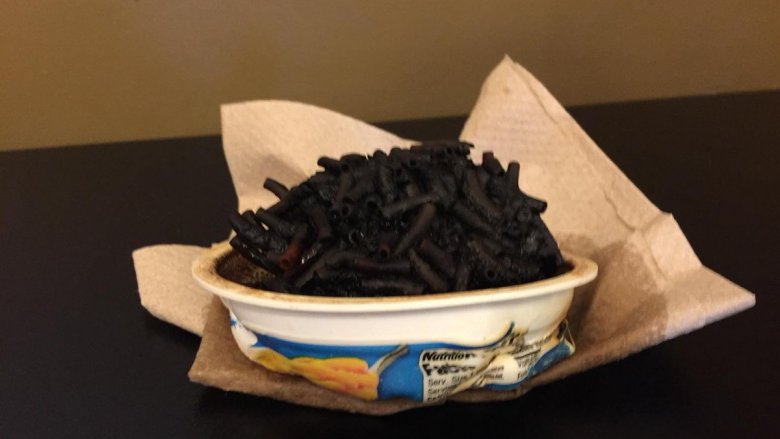The Untold Truth Of Kraft Macaroni & Cheese
Most of us can look back on our childhoods and recall eating bowls full of the iconic blue box mac and cheese, probably off of a metal TV tray depicting your favorite cartoon characters. Depending on who you ask, it's still the epitome of comfort food in adulthood, and maybe we still eat it off a metal TV tray (don't judge). There's just something about that bright yellow cheese sauce that soothes the soul — though it is less bright these days, thanks to a recipe reformulation.
But as much as we loved — and still love — Kraft Macaroni & Cheese, there are probably a few things left to learn about it. Do you know how it was invented? Or how what country gobbles down the most of it per week? And most importantly, did you know that you may have been making it wrong all these years? Don't worry — we'll tell you how to do it right.
Read on to find out all the little known factoids about your favorite cheesy pasta.
It's always been super cheap
Kraft Macaroni & Cheese has been around since 1937, but the company didn't invent the dish — Smithsonian.com reports that the earliest known recipe dates back to 1769 — but Kraft did patent the processed cheese that would ultimately change the game for the company during the Great Depression.
The idea to box the pasta with the processed cheese as an easy dinner (with an incredibly long shelf life and no refrigeration required) came about when Kraft learned of a salesman selling pasta with a packet of Kraft cheese attached with a rubber band. According to The Walrus, Kraft began marketing the product as Kraft Dinner, with the box promising to feed a family of four for the low price of only 19 cents. Because of its affordability, combined with its ability to feed a family, the product flew off shelves and sold 8 million boxes in the first year. World War II kept the popularity of the product going, due to the food rationing that was in effect. Two boxes of Kraft Dinner could be purchased for one rationing coupon, and scratched an itch as a substitute for unobtainable meat and dairy. Because of this, 80 million boxes were sold in 1943.
Kraft Macaroni & Cheese continues to be a super affordable option for a quick dinner in 2018, which at about $1 is a steal considering regular inflation rates should have it over $3 today.
You're probably making it wrong
How many times have you stirred up your pot of mac and cheese only to be left with a clumpy mess? That classic Kraft cheese powder, tasty as it is, just doesn't always play nice with the butter and the milk. But there's a way to make sure it does, and you'll never bite into a powdery lump again.
The key to creamy, dreamy mac and cheese is simply adding the ingredients in the correct order. Resist the temptation to throw everything into the pot at once — a little patience will pay off. Here's how to do it the right way:
- Once the noodles are cooked and drained, add them back to the pot.
- Add the butter, and stir until completely melted. (This is important.)
- Sprinkle the cheese over the top of the buttered noodles, then pour in the milk.
- Stir the noodles using a folding motion, from the edge of the pot inwards.
Voilà! No lumps, no bumps. Just deliciously creamy mac and cheese.
Is it really toxic?
A 2017 study of boxed mac and cheese had people swearing off one of their favorite comfort foods due to the presence of phthalates. But what the heck is a phthalate, and should we really be worried?
Phthalates are a group of chemicals commonly found in things like rubber, fragrance, soap, plastic, and more. These chemicals get into foods during the manufacturing process, and a small study found that 29 of 30 cheese products tested contained phthalates, with the powdered cheeses containing the highest amounts — four times more than natural cheese. CNN reports that these chemicals are endocrine disruptors, and according to the National Institutes of Health, "may interfere with the production or activity of human hormones." They may cause reduced fertility and an increase in some diseases, including endometriosis and some cancers."
Because of a lack of scientific data, the US Centers for Disease Control and Prevention says "the impact of low level exposure on humans is unknown," but certain phthalates have been banned in children's products since 2008.
So where does that leave us with our beloved mac and cheese?
You can probably still eat it
After the initial panic that the phthalate study caused, prompting scary headlines urging us to ditch our mac and cheese, it was revealed that it's probably not as bad as it initially seemed. Although it sounds scary, the study shows a higher concentration of phthalates in powdered cheese compared to natural cheese, but not in comparison to... anything else. So we don't really know how much is too much.
In response to the study, Kraft said, in part, "We want you to know that we do not add phthalates to Kraft Mac & Cheese... The safety of phthalates has been assessed by the US Food and Drug Administration and other authorities, such as the Centers for Disease Control. The trace levels found in the one limited test of mac and cheese are well below any level of concern. Hundreds of servings of mac and cheese would need to be consumed daily over an entire lifetime in order to exceed levels determined as safe."
Slate reports that Dr. Sheela Sathyanarayana echoed Kraft's statement, saying it would take a lot of mac and cheese to see negative impacts. "There's really no dose that we know that will lead to significant health effects," she said.
The study itself even concludes that "further research is needed on the phthalate levels in food," so we'll take our chances until then.
What's the white powder in Easy Mac?
If you've ever made Easy Mac — Kraft's microwavable alternative to stovetop mac and cheese — you might have pulled back the lid and noticed a white powder inside. No, it's not the cheese powder — that's contained in its own packet. So what is it?
If you checked the cooking directions, you would see that the package reads "Note: You will see loose white powder in pasta. This is necessary for proper cooking." The Huffington Post reached out to Kraft to find out just what that loose white powder might be, and were told that it is actually modified food starch. The representative explained that the starch is there to prevent the Easy Mac from boiling over in the microwave and acts as a thickening agent.
According to Bob's Red Mill, modified food starch is in just about all instant and processed foods these days, and it's commonly made from corn, wheat, potato, and tapioca — something to keep in mind if you have allergies.
The recipe change nobody noticed
So you think you know your Kraft Macaroni & Cheese, do you? Did you notice when they changed the recipe without telling anyone?
In what Kraft called "the world's largest blind taste test," it was revealed in March 2016 that the company had overhauled their original mac and cheese recipe to remove artificial flavors, preservatives, and dyes. But the change actually took place in December 2015, and by the time they let us all in our their secret, they'd sold more than 50 million boxes without anyone noticing.
Kraft Heinz's Greg Guidotti said in a statement, "As we considered changing the ingredients of our classic Blue Box, we did so knowing we had to maintain our iconic look, taste and texture. We'd invite Americans to try our new recipe, but they most likely already have." Well played, Kraft, well played.
The recipe reformulation came in response to a petition started by the infamous Food Babe (which garnered more than 350,000 signatures), and an increase in consumers' desire for simpler ingredients. That classic yellow color is no longer achieved with yellow 5 and yellow 6, but paprika, annatto, and turmeric.
Canadians REALLY love it
You might think Kraft Macaroni & Cheese is popular in the U.S., but Canadians are way more serious about their boxed cheesy pasta than Americans. They eat so much of it that they've made Kraft Dinner, or KD as it's now officially called, the top selling grocery item in their country, with each person eating an average of 3.2 boxes each per year, which is an astounding 55 percent more than Americans eat. Canadians are also responsible for a good chunk of the worldwide mac and cheese consumption, eating 1.7 million of the 7 million boxes sold each week.
It's not just pride for their own country's product, either. In BuzzFeed's blind taste test, Canadians picked KD over Kraft Macaroni & Cheese as the winner four out of four times. Sounds like they all agree with the Barenaked Ladies who famously sang,"If I had a million dollars / We wouldn't have to eat Kraft Dinner / But we would eat Kraft Dinner / Of course we would, we'd just eat more."
The cheese powder isn't just for macaroni
If you love the unmistakable flavor of Kraft's patented cheese powder, why aren't you using it in other dishes? It's not just for your mac and cheese anymore. Thanks to the geniuses at the Chicago Tribune, we now have several more ways to get more cheese powder in our lives:
- Instead of rimming your Bloody Mary glasses with salt or other seasonings, go for cheese powder. It still gives you a salty kick, and pairs well with tomato and Worcestershire sauce. Just dip the rim in a little lemon juice first to get the powder to stick.
- Make easy cheesy popcorn by sprinkling the powder onto popped buttered kernels and tossing well.
- Whisk some cheese powder into your eggs before scrambling to add a bit of creamy umami to your breakfast plate.
- Homemade Doritos anyone? Yes, it's possible. Just spray tortilla chips with cooking spray and toss with a mixture of cheese powder, paprika, and cayenne before baking at 300 degrees for 10 minutes.
Why stop there? Mix it into butter, toss it with fries, sprinkle it on top of baked potatoes or veggies... the world is your cheesy oyster.
Easy Mac might not be so easy after all
The appeal of Easy Mac is that it's — you guessed it— easy. Ridiculously so. You add water, you microwave it for 3-1/2 minutes, you stir in the cheese, and, in a perfect world, you're eating lunch less than 4 minutes later. In a less than perfect world, you burn your Easy Mac to an unrecognizable pile of charcoal, cause an evacuation of your office building, and (presumably) hide in the bathroom the rest of the day.
That's exactly what happened to one unfortunate employee at the Iowa State Capitol anyway, who just wanted to satisfy their lunchtime mac and cheese craving. The scorched Easy Mac set off emergency smoke alarms near the Senate Chamber and forced an evacuation of the building.
Moral of the story? Don't walk away from your microwavable mac and cheese. It turns out it might not be so easy after all.
